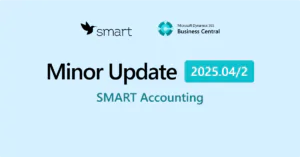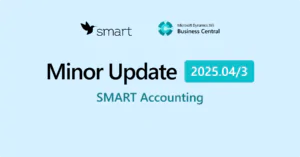Solution updates for Ukraine, Azerbaijan, Georgia, Cyprus, and Poland are released every 3 months. If changes in the legislation are urgent, SMART business releases urgent unscheduled updates.
All updates can be installed independently or with the help of SMART business.

- The Declaration of Income has been updated to version 27 to comply with the requirements of the order of the Ministry of Finance effective April 24, 2025, No. 215.
- The option to indicate the use of the cash method for VAT accounting has been added to the VAT Declaration and table 2.1, Appendix 1 of the VAT Declaration.
- New functionality — “Purchase VAT Invoice Reconciliation” — has been added for verifying and matching lines of imported purchase VAT invoices with the lines of posted purchase invoices or released purchase orders.
The feature enables searching and visually comparing VAT invoice lines with corresponding purchase invoice/order lines, as well as setting or removing matches. Once matched, the functionality automatically compares the UKTZED/DKPP codes and Imported Goods Indicator with the respective purchase document lines and highlights any VAT invoice lines with discrepancies.
- A new “VAT Processing Order” field has been added to the Customer Entries. By manually changing the value of this field (for example: values 1, 2, 3, 4), users can influence the order in which VAT Sales Invoices are generated within the same day — either by order number or agreement number, depending on the selected chain logic.
- The ability to create a Compensating VAT Invoice on imported items based on the Inventory Shipment has been added.
When using the “Split lines by applying” function in the Inventory Shipment, the customs declaration number will be automatically filled in for each purchase transaction. The logic for forming the item description in the compensating VAT invoice for imported items has been updated — the description now includes the dates and numbers of customs declarations from the Write-Off Act.
- A new import format for Monobank bank statement from the web version of the banking application (in CSV format) has been added. This format is available for import when the Import Format is set to “Monobank (web) CSV” on the Bank Account card.
- The ability to print the document “Invoice-request for release/internal movement of materials” from the system document “Posted Direct Transfers” has been added.
- The ability to set filters based on Dimension values on the Closing Account in the “Manufacturing Charge Assignment” request form in the Item Revaluation Journal has been added.
- The Item Entry Type Assembly Output has been added to the “Add Journal Lines” function on the “Item Revaluation Journals” page, and the filter by Entry Type has been configured.
The mechanism of creating lines through the “Add Journal Lines” function has been refined, when the system does not block the creation of all lines due to the fact that there are operations with indications Completely Invoices=No and/or Positive=No in the period. Instead, the system informs the user for which operations the lines will not be created and gives the option to choose to continue creating the remaining lines or not.
- The functionality for accounting of fixed assets with the type “Future Expense” has been updated. The issue with automatic filling of the Depreciation Book has been fixed — now, after selecting the fixed asset type “Future Expense”, the system pulls the corresponding Future Depreciation Book according to the settings.
When posting the acquisition of such a fixed asset, its status is automatically changed to “Operation”, and the depreciation start date is determined based on the formula where the posting date is used as the base date.
- The “Set additional filters” button has been added to the G/L Account Turnover page for setting some additional filters by available fields of the G/L Account Card.
- The logic for inheriting the Service code for “Service” type items in related purchase and sales documents created based on posted invoices has been refined.
- The functionality of the Item Net Amount Sheet and Item Net Amount Quantity Sheet has been improved — dropdown lists have been added to the filter fields for easier selection.

- The form of report “Notification of new employee’s (home employee’s) hiring/signing the gig-contract” has been updated according to the Resolution of the Cabinet of Ministers of Ukraine effective February 21, 2025, No. 184.
- Changes have been made to the settings of the SSC payroll elements for Diia.City.
- The ability to specify a balancing G/L account in posting payroll groups for general ledger entries created for the vacation reserve has been added to enable monitoring and analysis of the amounts of accrued vacation reserve and UST, as well as the amounts of used vacations per employee in the detailed turnover statement with a filter by Source type = Employee.
- In the “Suggest Payroll Documents” task, a filter area has been added to search for employees who worked in a specific position on the “Posting Date” of the “Payroll Document”.
- For payroll calculation groups, a new value has been added to the Type field — “Between with posting”. When a payroll document with the corresponding payroll calculation group code is posted, G/L entries and Payroll Ledger Entries are generated.
- Changes have been made to the SSC payroll element calculation settings for Diia.City in the system. A new functionality has been introduced to enable the deposit of an employee’s salary in cases where it was not received by the employee within the established time frame due to reasons not related to the employer’s fault.
- The “Allow Posting in Closed Period” setting has been added for payroll elements. It allows posting a payroll element through the employee journal even if the payroll status in the corresponding payroll period is “Posted”.


